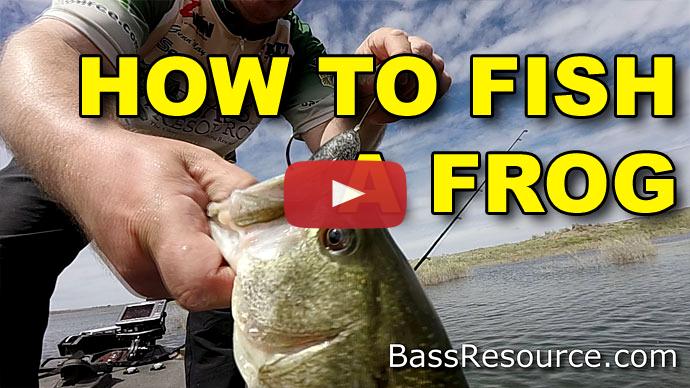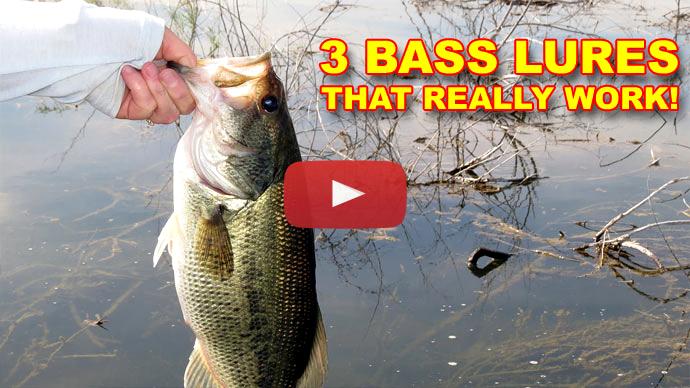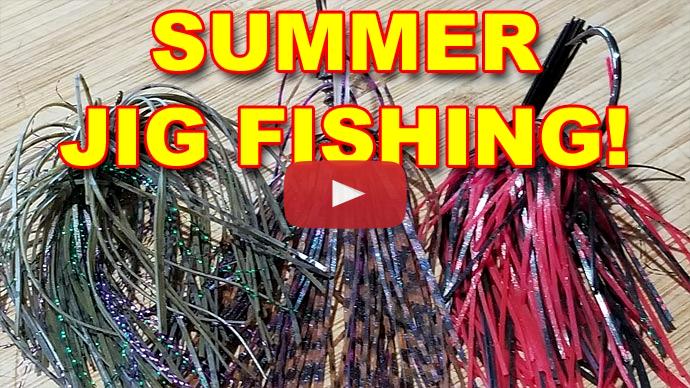You go to any good bass lake and it usually has an abundance of weeds. Why? Well, weeds are kind of, like, their own environment. They have shade, they have cover, baitfish can hide in them, they attract invertebrate and zooplankton insects, which the baitfish and small fish go into feed upon, and that, of course, attracts predator fish such as bass. So it's got this whole thing going on. It makes any bass lake really productive because it harbors all of that activity in it. It's hard to have a real good bass lake that is void of weeds. Weeds are an important component of having a healthy bass fishery. So how do you fish them? Because sometimes you go to these lakes and there's weeds all over the place and like, "Oh, gosh, how do I do this?" Well, that's what we're going to talk about today. Let's break it down for you, make it really easy. First of all, how do you identify a good weed bed and how do you identify the areas within that weed bed that are hot spots? And then we're going to talk about how do you fish those areas.
So let's first of all, how do you identify a good weed bed? I think the first thing, right off the gate is if you've got brown or dying weeds such as you have in the fall, going in during the wintertime, those are areas don't even bother. Again, green weeds, they produce oxygen and that's what gives all that life to it. When it's a brown weed, they're dying or dead, and they're not producing any oxygen, and all those living creatures that I just mentioned, vacate the area, they're gone. So don't fish brown weeds. That's the easiest way right there to just cut out all that stuff. Now, when you're looking at a bunch of weeds, another area that I tend to avoid is when it's a real vast big area of one kind of weed, like a giant lily pad field. And it's huge. It's like a couple of football inks, wide and deep, like giant. I tend to avoid that because it means that the bottom contour is all one contour. It's pretty much all the same depth, pretty much the all same bottom composition, and it's only one kind of weed without any variance at all. That doesn't really attract bass.
Bass like variety. And so one of the things to look for, there's three main things to look for to make a good weed patch, besides being a smaller weed patch. Smaller meaning 50 yards or 100 yards at most. It's change of depth. It's structure. Structure is the contours of the bottom of the lake or river that you're fishing. Weeds on changing structure is going to attract bass. So weeds sitting on a point, for example, that taper off into deep water, weeds that are near the edge of a drop-off, or on a drop-off, or on a steeper drop terrain, or on the top of a hump or a ridge or a ledge, these type of things. Where the depth of the lake changes somewhat rapidly, that's going to set up weed edges and pockets in the weeds. Those weed edges is what you want to fish. And most especially, it's irregularities, not just a straight line, but irregular changes in that weed edge. And so you have points, and pockets, and coves, and cuts in the weeds. Those are the things that are going to attract bass. So weeds on structure, that's important.
Another component is cover with weeds. Now weeds is a type of cover, but now I'm talking about other types of cover such as boulders, stumps, laydowns, things like that which will break up the weeds. Sometimes you'll see a patch of weeds and there'll be a hole in the middle of it. That's because there's a stump there or maybe a rock that's kind of breaking that up. And bass, they like to sit on these edges and ambush baitfish as they come by. They use that as ambush points. That's why these irregularities are so good because that's an area where bass is going to set up, and wait for a baitfish to come by, and dart out and get them. So things that are inside the weed patch that break it up and cause these little irregular edges, that's also gonna be a hot spot. So you look for those things. Even man-made structures like docks or wing dams, things like that, that can break up the weeds, those can be hot spots. Like, you got lily pads and you got a dock, well, there aren't any weeds underneath the dock because the sun can't penetrate. Well, that's gonna form an edge plus a canopy with a dock. That could be a good hot spot. So I like to fish docks that have got weeds on each side of them, for example.
And then the third element is a combination of different kinds of weeds. So lily pads, maybe with some milfoil in it, maybe some cattails, pelota, maybe some hydrilla, just a mix of weeds. Two or more mixtures of weeds, the better. Now, why is that? Well, learn your weeds. It would be very helpful if you study the weeds because you'll find that different weeds grow in different depths. Some of them grow taller than others, and they also prefer different bottom types. Some want a more firmer bottom, others want a soft mucky bottom. For example, lily pads grow in soft mucky bottoms, whereas reeds, and pencil grass, and pencil reeds, things like that, grow in firmer bottoms. Now, this can be very important, for example, during the spawn. When the fish are up looking to make beds during the pre-spawn in the spawn, they're going to look for firmer bottoms. And if you know what kind of weeds grow in firmer bottoms, it's really easy to find those where the fish are congregated. I've gone on lakes brand new to me, never been on before. During the pre-spawn in the spawn, I just scan the shoreline and I see here's the reeds and the cattails, and I go straight to them and boom, fish. Boom, I'm on them. And I've had people like, "How did you do that? You've never been to this lake." That's it. I'm telling you, right? Straight up, that's the secret. It's just knowing your weeds.
Same thing with the different types of weeds when they're growing together. That may tell you a mix of the bottom composition, and those transitions and changes, and it might even be a change in depth. Those things, those irregularities, is what's going to concentrate the fish and attract them. So that's what makes a good weed bed, looking for those things, those changes in contours, those changes in types of weeds, and other type of cover associated with them, that's what you want to concentrate on when you're fishing weeds. How do you fish weeds and grass? Well, there's a variety of ways to do it. The first one is kind of alluded to, but the fish like to sit on the edges. The bass will sit on those edges, and dart out and hit prey. So the first thing I do, is fish those outer edges with faster moving horizontal presentations. So spinnerbaits, crankbaits, buzzbaits, paddle tail swimbaits, swim jigs, a chatterbait, things like that that you can run along the outside edges of those weeds. Outside edge, by the way, I mean that's the edge that's facing the main body of water. Inside edge would be the weeds that are facing the shoreline.
So, typically, they sit up on the outside weed edges except for during the spawn. So those outside weeds is what you want to target with those horizontal moving baits. Even topwaters like chuggers and poppers, buzzbaits, things like that can work really well along those weed edges. Now sometimes what happens is people will fish that in the early morning, and then when the sun comes up, the bite dies down, and they automatically think, well, the fish have abandoned the shallows, they're now deep and they've got to go out and fish deeper. Now, a lot of times, that's the fisher there for a reason. Baitfish. And they're not gonna leave the food source. So what do they do? They bury up and get in deeper into the weeds, and chase them around in there because the baitfish aren't gonna come out and brought sunlight because they can be seen easier. So they hide deeper in these weeds. So the bass are gonna go in after them. So you too need to go in after them. So the best way to do it, there's two ways to do it. You can do it on top. So if the weeds, for example, they grow up and they stop growing about a few feet underneath the surface of the water, those are called submergent weeds. You can go over the top of those with shallow crankbaits such as a lipless crankbait, like a rattletrap, or you can go with a buzzbait, spinnerbait, paddle tail swimbaits, swim jigs, things like that over the top of them and entice the bass to come up out of the cover, out of the weeds and out of the grass and smash them, which is a fun way of fishing. Sometimes that can be some of the most productive.
Again, you wanna look at those irregularities inside the weed patches. So places where a rock and boulders may be or a stump, something that breaks it up, those openings in the weeds, you wanna make sure you bring your bait across that and over the edges of them because that's a lot of times where the bass are set up. Now, if the weeds have grown up over the top, and they've formed a canopy over the top, say for example, lily pads or maybe during the late summer you get this mass of vegetation which will happen with, hydrilla will do that, milfoil will do that. You can fish over the top again. This time I would do things like a frog, or a toad over the top, or a spoon like a Johnson Silver Minnow. You can bring that over the top of the weeds and just a constant speed. You don't want to stop and go in this instance because the bass need to be able to track it. They don't see it, they feel it and they can hear it. So you need to keep constant motion for them to be able to hone in on it and nail it. Again, bring it to those open pockets. Bring it across those open pockets, cast past it and bring it over to those open pockets, and a lot of times as soon as it breaks into that open water, pow, they nail it. So be ready for that. Don't be startled by it. It can happen and it's exciting, a fun way to fish.
The other way to go after the fish in these situations, if you can't get the lure over the top or you're not getting bites by bringing it over the top, whether they're emergent or submergent weeds, is to go in after them with jigs and with Texas rig plastics or like a Texas rig tube bait, something like that. Again, you're throwing, flipping, and pitching into those pockets, those little open areas. That's the areas you really want to focus on. And hold on tight because a lot of times the bait doesn't even hit the bottom. It gets nailed right away. Senkos can do that. I like throwing Senkos out in lily pads. Just bring the Senko across the top of the lily pads to the opening, let it drop into the opening, let it just flutter down, do its thing. A lot of times it gets snatched up before it even hits the bottom of the lake. So those are some ways to go in after them and catch a lot of fish that way. If you've got this canopy, you can still go in after them. What you need to do is heavy up. Now you're going to use a 1/2-ounce to an ounce and a 1/2 bullet sinker on it, like a tungsten weight, and Texas rig, small creature bait behind it. And you toss it up in the air a bit and let it punch through that canopy. And once it punches through, a lot of times that's when it gets inhaled by a fish. So you need to use stout equipment when you're going into the weeds.
Any of these techniques I just mentioned, when you're going into the weeds to get the fish, this is where you need like a heavy power fast action or heavy power extra fast action rod, you know, a 7'4'' to 7'8'' rod with a lot of leverage to be able to get that fish out. You're using braided line, 50-pound, 65-pound braid, 4/0, 5/0, flipping hook. Those are the type of things we're talking about. It's just a hand-to-hand combat fishing, but it can be a lot of fun. The idea here is once you set the hook, you want to get the fish turned to you, and reel them in as fast as you can. Keep that rod tip high. This is one of the reasons why you want a longer rod. Keep them up and get that fish pointed at you as you reel, reel, reel, so he doesn't have a chance to wrap up around all those weeds and grass, and then use that as leverage to rip free. So, you need that stout equipment to do that. This is not a game for light spinning rods and 10-pound lines. So, that's kind of how you go after the grass. Oh, let me get one more thing. In the wintertime, a lot of those weeds have died off, but you can still find green weeds. And this is what it's all about. Going back to the very beginning of this video, green weeds is what you want.
In the wintertime, the remaining green weeds that are there are going to concentrate the fish. You just got to look for it in deeper water. And deeper is all relative in the lake, but when it comes to weeds, it's how deep can the sunlight penetrate. Typically, that's 20 to 25-feet deep. Sometimes it'd be a bit deeper, sometimes shallower, but if you can, again, look at it with different structure. Weeds on the top of a hump in 20-feet of water or on a point, during the wintertime, can be hot spots and you can catch a lot of fish that way. You just got to get a lure down to them. Deep-diving crankbaits can do it. Jigs, paddle tail swimbaits, slow-rolling spinnerbaits, you're getting the idea here, Texas rig plastics. Things you can get down to that depth, and down towards those weeds, in and around those weeds. Definitely, fish those during the colder months and you can have yourself a really good day. So I hope that helps. A lot of ways to hit a weed and catch a lot of fish out of weeds. I got other videos that go into much deeper detail in the different types of techniques, the way of fishing weeds. Be sure to take a look at them, and I hope you catch a lot of fish that way.



